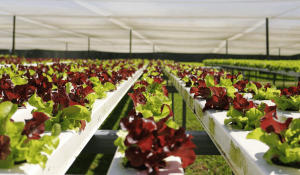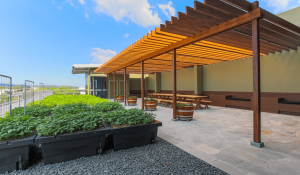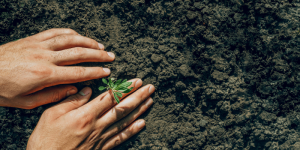
In Australia’s vast and diverse landscapes, where unique flora and fauna thrive, one grass species stands out for its ecological importance, cultural significance, and remarkable adaptability. Kangaroo Grass!
Kangaroo Grass (Themeda triandra) is a native grass once harvested by Indigenous people but is these days often overlooked as a roadside weed. However, don’t be fooled. Researchers say it could form the solution to restoring land exhausted by farming (Lawrence, 2021).
Green Endeavour has Kangaroo Grass flourishing in the lush garden beds surrounding our Brisbane office. The purpose is to help educate staff and customers on the benefits of this perennial native crop and also to do our part in helping preserve it. You can read more about the benefits of our gardens here.
What is Kangaroo Grass?
Also known as Themeda Grass or Redgrass, Kangaroo Grass is a perennial bunchgrass native to Australia. It is one of the most widely distributed species spreading across ecosystems, from coastal areas to woodlands, grasslands, and mountain regions. Its distinctive appearance includes long slender leaves that turn a striking reddish hue as they mature, providing a vibrant touch to the landscape. It is widely distributed worldwide, with species growing throughout Africa and Indonesia (Future Beef, 2011).
Ecological Significance
Soil Health: Soil loves Kangaroo Grass! It plays a crucial role in maintaining soil health. The extensive and deep root system helps prevent erosion by stabilising the soil, making it particularly valuable in areas prone to degradation.
Biodiversity Support: The dense tufts provide habitat and food for various wildlife species, from butterflies to birds and even lizards. Its seeds are a vital food source for many birds, helping to sustain local ecosystems. Lawrence, 2021, stated that the crop essentially “creates its own ecosystem.” It helps conserve moisture, therefore, attracting various insects and invertebrates.
Fire Adaptation: This grass responds remarkably well to Australia’s fire-prone environment. It responds well to regular burning and spelling, possessing a unique ability to resprout after fires. This is all thanks to the crop’s ability to keep moisture within the soil beneath it.
Crop Resilience: This stuff can withstand just about anything, from droughts to fires! Samples of the grass are thought to be over 50 years old (Lawrence, 2021). In Australian agriculture, you would be hard-pressed to find another grass that’s been alive for that long.

Cultural Connections
Kangaroo Grass has deep cultural significance to Indigenous communities across Australia. It has been utilised for centuries for its versatility and practicality. Some Indigenous uses include:
Food Source: The seeds were traditionally harvested and ground into flour for making bread and damper, adding to the sustenance of Indigenous communities.
Craftsmanship: The grass stems were used for weaving baskets, mats, and other intricate crafts, showcasing the resourcefulness and creativity of Indigenous cultures.
Ceremonial Purposes: Kangaroo Grass held spiritual and ceremonial importance in various Indigenous traditions, contributing to the rich tapestry of cultural practices.
Preservation and Conservation
Despite its ecological and cultural significance, Kangaroo Grass populations face threats due to urbanisation, land clearing, and changing land management practices. Preserving this remarkable grass species requires land managers, communities and researchers’ contribution.
Land Managers can do their part by adopting sustainable land management practices that prioritise the preservation of native vegetation to aid in long-term survival. Communities can help by raising awareness about the value of Kangaroo Grass and its role in maintaining healthy ecosystems. This will encourage local communities to get involved in conservation efforts.
Further research on the ecology and biology of Kangaroo Grass can inform targeted restoration initiatives. Reintroducing the species to degraded areas can help restore biodiversity and ecosystem functionality.

Could Kangaroo Grass be a New Food Crop?
The Dja Dja Wurrung Aboriginal Clans Corporation are in the midst of a four-year project with the help of a $1.82 million Federal Government grant. The project is aimed at researching the viability of growing Kangaroo Grass. The goal, according to Project Manager and Agronomist Latarnie McDonald, “is to eventually see it become a regular food source that is grown on a commercial scale.”
The team hopes the product will become a staple ingredient in bread, cakes and biscuits (Lawrence, 2021). It is said to be quite tasty, with a nutty flavour resembling a scone! According to McDonald, early research concluded that Kangaroo Grass has 40% more protein than traditional grain used in bread.
Bridget McKenzie, Australia’s first female Agriculture Minister in 2019, said the project would draw heavily on traditional Indigenous knowledge. In turn, helping farmers develop more of an understanding of factors limiting germination and the species’ success in a commercial cropping situation.
Kangaroo Grass is more than just a plant; it is a living testament to the intricate connections between ecology, culture, and the land. Its vibrant presence in Australia’s landscapes speaks to the resilience and adaptability of native species.
As we navigate environmental conservation challenges, Kangaroo Grass will hopefully become a staple grain crop grown and protected by Australian landowners and communities.
References:
Future Beef. (2011). Kangaroo Grass. https://futurebeef.com.au/resources/kangaroo-grass-themeda-triandra/
Lawrence, S. (2021). Could native crop, kangaroo grass, become a regular ingredient in bread and help farmers regenerate land?. ABC News. https://www.abc.net.au/news/2021-02-08/kangaroo-grass-quest-as-the-next-super-crop/13132462



